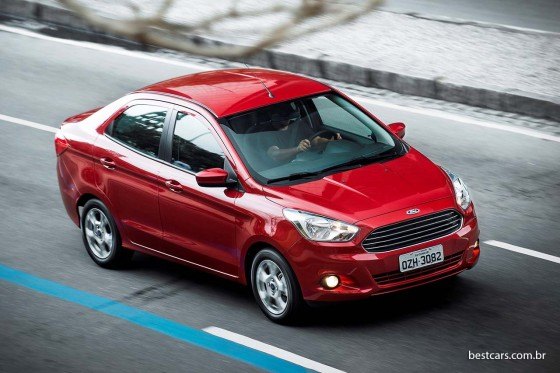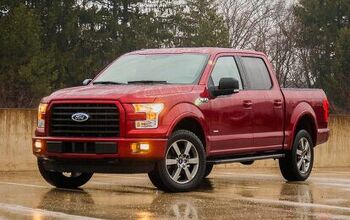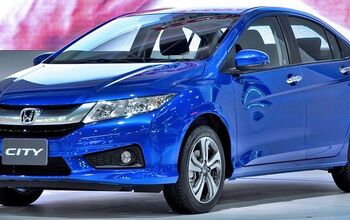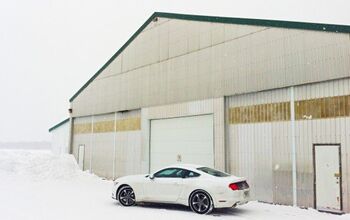Capsule Review: 2015 Ford Ka (Brazilian Market)

The Ford Ka was born as a provocateur with a challenging design and hints of refinement that solidified the idea that cars are not sold by the pound. Highly successful in Europe, this recipe proved less so in the rest of the world, particularly Latin America were the car was relentlessly cheapened out over its career and became irrevocably divorced from the European car in its second generation. Now, designed and developed by Ford Brazil (with some help from the European unit), the Ka, in its third generation, sets out from the tropics in its eventual quest to become an integral part of the One Ford strategy (sales in Europe, from a UK beachhead, should commence in the fall of 2015).
This time around the Ka will be Ford’s cheapest offering, nestling under the Fiesta. Though it is shorter than its cousin, its wheelbase is exactly the same. The new Ka is taller and a hair wider, offering a greater sensation of roominess in its interior. If front seat space is comparable, the back seats have been placed further back and due to the high roofline, four non-NBA sized people can sit in good comfort, especially by segment standards. As in everything else in life, this decision brought with it a definite drawback: The 257 liter trunk is the smallest in its category. While not such a problem in Western Europe, were cars like this are viewed as urban runabouts, it definitely could be blight for the Ka’s career in much of the rest of the world. In these markets, a Ka is expected to pull family duty and the trunk is tight for a family of four come vacation time.
The new Ka is also a very interesting statement on how Ford sees the Brazil and other developing auto markets. In Brazil the car starts off at 35,000 reais, whereas some competitors are offered at 25,000 reais. When equipped like the Ka, however, Ford’s pricing becomes competitive, maybe even aggressive. Features like assisted steering, air conditioning and power windows have become the new norm, and the Ka’s equipment levels are commensurate with its price. Ford claims they want the retail sales title and will have to sell over 10 thousand cars a month to reach their goal.
For that amount of money the Ka offers the items mentioned, but extras like electronic brake distribution, hill holder, Sync and even its version of an emergency call system, the first for any car in Brazil. Other sophisticated items like ESP are offered depending on version, and a first for the small car segment in Brazil.
Stepping inside the car, besides the roominess already mentioned, the care taken in its finishing is immediately noticed. While hard plastics are the norm, they are decently assembled and different textures and color are duly appreciated. Internal design and layout is inspired by what is seen in the Fiesta. Cubbies to put modern life’s unavoidable accruements are offered generously and Ford claims there are 21 of them, though I didn’t notice all of them. However, there are more places to accommodate stuff than in the Fiesta and most competitors. Overall impressions are good.
Stepping back out to see the design, the car’s height is readily apparent. As confirmed by the tape measure, the car is and looks taller than anything else in the segment. As it is relatively short and wide, to some the car will look fat. To my eyes it doesn’t seem so, but the height is a bit of a challenge. The front fascia clearly follows Ford’s Aston Martin-inspired ideal and is still a very nice look. The side profile is also eye pleasing, with a high belt line that Ford managed to make not too intrusive as sightlines are good. The car’s worst design element is the back. Comparing to the front and even its profile, it is demure to be sure. Maybe even too timid for what the front suggests.
Mechanically, the car begins to stand out to the enthusiast. The car uses a naturally aspirated, 1 liter, 3 cylinder, 12 valve, flex fuel version of the engine already on sale in Europe and North America, but without the turbocharger. It features variable valve timing in both the intake and exhaust, and other tricks like separate cooling for head and block. The crankshaft is built so there is an angle between flywheel and pulley, a simple solution that eliminated much of the bothersome vibrations inherent in 3 cylinder engines without having to resort to extraneous measures. Ford also promises low upkeep costs. For example, the engine features an oil bathed chain that requires no maintenance for 240,000 kilometers. This small power plant produces 80 horsepower using Brazilian gasoline or 85 ponies should you choose to fuel it with ethanol. This makes it the most powerful naturally aspirated 1.0 liter engine in Brazil and, quite possibly, the world.
The best part about driving this engine is its refinement. It pulls very progressively from 1500 RPMs up to redline. Couple that with its long fifth gear, and it’s a comfortable cruiser at speed. The sprint to 62 mph is done in about 14 seconds, which is very good in the category. Were it not for a certain sluggishness in its response, and the existence of the new Volkswagen up! (which also uses a 3 cylinder 1.0), this could be considered the best 1.0 in the Brazilian market, bringing heat to some of the 1.4 and 1.6 liters available. Though smaller, the up! is undeniably faster and even more economic. It also sounds better, though it vibrates more than the Ford.
The first Ka had a kart-like ride that enthusiasts appreciate ( myself included). The back for example always threatened to let loose in curves if the driver hesitated in accelerating. The new Ka does not touch that level of sportiness, but its manners driving fast or slow are impeccable. The suspension does not allow unnecessary roll, yet manages not to be uncomfortable. Handling is precise, the electric steering is very light in urban driving and becomes heavier the faster you go (though still numb compared to hydraulic setups), noise and harshness are contained and I didn’t notice any squeaks and rattles from the finishing. Again, probably the best suspension available in small cars in Brazil, were it not for the up!.
The new Ford Ka is a well-rounded, relatively sophisticated modern car. Offering space (at least for passengers) and an undeniably modern, efficient and fun ride and engine, it is poised to become a sales leader in places where small cars are appreciated. It is on sale in Brazil and the sedan version, the Ka+, will begin sales next month. It will soon be exported to other South American markets. It will also be produced in India and sold all over the world. It is a shame North Americans will probably not get it because it continues Ford’s tradition of offering advanced and pleasant small cars.

More by Marcelo de Vasconcellos
Latest Car Reviews
Read moreLatest Product Reviews
Read moreRecent Comments
- SCE to AUX It's over, and over the last decade or so Henrik Fisker has left two eras of foolish customers driving paper weights.
- Kwik_Shift_Pro4X Always a good sign. 🤕 I would like to see their pitch on Shark's Tank/Dragon's Den
- Buickman I was called crazy after predicting the sale of GMAC.#canthurtme
- 3-On-The-Tree Another observation during my time as a firefighter EMT was that seatbelts and helmets do save lives and reduce injury. And its always the other person getting hurt.
- 3-On-The-Tree Jeff, Matt Posky, When my bike came out in 1999 it was the fastest production motorcycle in the world, 150 HP 197 top speed, 9.57 quarter mile Hayabusa peregrine falcon etc. This led to controversy and calls for high-speed motorcycles to be banned in order to avoid increasingly fast bikes from driving on public roads. This led to a mutual decision nicknamed the “ gentleman’s agreement” to limit bikes to 186mph, ending the production bike speed contest for all bikes 2000 and upward. Honestly once your over a buck 20 it’s all a blur. Most super cars can do over or close to 200mpg, I know at least on paper my 09 C6 corvette LS3 tops out at 190mph.








































Comments
Join the conversation
Interesting car, or Ka. Seems like this would be a better seller in the US than the too tight in the back Fiesta. Mine would have to be the hatch, the sedans this size are just so very useless, whatever the "trunk prestige".
Balancing any rotating system can be accomplished by applying appropriate masses at appropriate radii. at appropriate angle to each other at each end of the rotating shaft. Basic theory, and what Ford has come up with by reading textbooks. That's balanced to the external observer, the engine mounts and you the driver. Utter vibration hell can still be going on inside the system - outside seems serene. The timing belt is not a chain. It's a belt designed to run in oil. Surely the last Ka is a Fiat 500 - they were both built in Fiat's factory in Poland on the same platform.. The first gen Ka was as close to a British chocolate biscuit tin as any modernish car with the last gasp of the Ford Kent ohv engine as motive power. Cheap and built to stay that way.